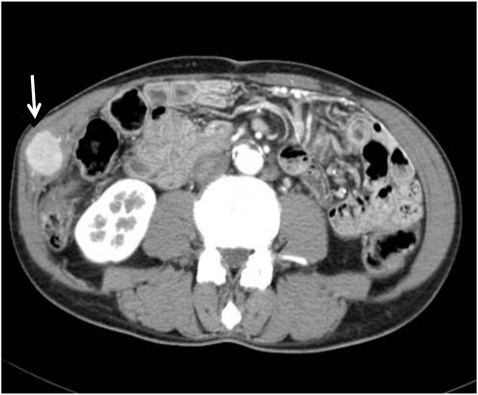1. Donato MF, Arosio E, Del Ninno E, Ronchi G, Lampertico P, Morabito A, et al. High rates of hepatocellular carcinoma in cirrhotic patients with high liver cell proliferative activity. Hepatology 2001;34:523-528. 11526538.


2. Llovet JM, Bustamante J, Castells A, Vilana R, Ayuso Mdel C, Sala M, et al. Natural history of untreated nonsurgical hepatocellular carcinoma: rationale for the design and evaluation of therapeutic trials. Hepatology 1999;29:62-67. 9862851.


3. El-Serag HB, Mason AC. Rising incidence of hepatocellular carcinoma in the United States. N Engl J Med 1999;340:745-750. 10072408.


5. Fornari F, Civardi G, Cavanna L, Rossi S, Buscarini E, Di Stasi M, et al. Ultrasonically guided fine-needle aspiration biopsy: a highly diagnostic procedure for hepatic tumors. Am J Gastroenterol 1990;85:1009-1013. 2165350.

6. Taavitsainen M, Vehmas T, Kauppila R. Fatal liver necrosis following percutaneous ethanol injection for hepatocellular carcinoma. Abdom Imaging 1993;18:357-359. 8220036.


7. Lee JW, Han JK, Kim TK, Choi BI, Park SH, Ko YH, et al. Obstructive jaundice in hepatocellular carcinoma: response after percutaneous transhepatic biliary drainage and prognostic factors. Cardiovasc Intervent Radiol 2002;25:176-179. 12058212.


8. Okuda K. Intratumor ethanol injection. J Surg Oncol Suppl 1993;3:97-99. 8389182.


9. Di Stasi M, Buscarini L, Livraghi T, Giorgio A, Salmi A, De Sio I, et al. Percutaneous ethanol injection in the treatment of hepatocellular carcinoma. A multicenter survey of evaluation practices and complication rates. Scand J Gastroenterol 1997;32:1168-1173. 9399400.


10. Ishii H, Okada S, Okusaka T, Yoshimori M, Nakasuka H, Shimada K, et al. Needle tract implantation of hepatocellular carcinoma after percutaneous ethanol injection. Cancer 1998;82:1638-1642. 9576282.


11. Silva MA, Hegab B, Hyde C, Guo B, Buckels JA, Mirza DF. Needle-track seeding following biopsy of liver lesions in the diagnosis of hepatocellular cancer: a systematic review and meta-analysis. Gut 2008;57:1592-1596. 18669577.


12. Loew R, Dueber C, Schwarting A, Thelen M. Subcutaneous implantation metastasis of a cholangiocarcinoma of the bile duct after percutaneous transhepatic biliary drainage (PTBD). Eur Radiol 1997;7:259-261. 9038127.

13. de Sio I, Castellano L, Calandra M. Hemobilia following percutaneous ethanol injection for hepatocellular carcinoma in a cirrhotic patient. J Clin Ultrasound 1992;20:621-623. 1331193.


14. Livraghi T, Giorgio A, Marin G, Salmi A, de Sio I, Bolondi L, et al. Hepatocellular carcinoma and cirrhosis in 746 patients: long-term results of percutaneous ethanol injection. Radiology 1995;197:101-108. 7568806.


15. Shiina S, Tagawa K, Niwa Y, Unuma T, Komatsu Y, Yoshiura K, et al. Percutaneous ethanol injection therapy for hepatocellular carcinoma: results in 146 patients. AJR Am J Roentgenol 1993;160:1023-1028. 7682378.


16. Smith EH. Complications of percutaneous abdominal fine-needle biopsy. Review. Radiology 1991;178:253-258. 1984314.


17. Zerbey AL, Mueller PR, Dawson SL, Hoover HC Jr. Pleural seeding from hepatocellular carcinoma: a complication of percutaneous alcohol ablation. Radiology 1994;193:81-82. 8090925.


18. Fornari F, Civardi G, Cavanna L, Di Stasi M, Rossi S, Sbolli G, et al. The Cooperative Italian Study Group. Complications of ultrasonically guided fine-needle abdominal biopsy. Results of a multicenter Italian study and review of the literature. Scand J Gastroenterol 1989;24:949-955. 2688068.


19. Livraghi T, Damascelli B, Lombardi C, Spagnoli I. Risk in fine-needle abdominal biopsy. J Clin Ultrasound 1983;11:77-81. 6404941.


20. Smith EH. The hazards of fine-needle aspiration biopsy. Ultrasound Med Biol 1984;10:629-634. 6397887.


21. Oberholzer K, Pitton MB, Mildenberger P, Lechner C, Düber C, Thelen M. The current value of percutaneous transhepatic biliary drainage. Rofo 2002;174:1081-1088. 12221564.


22. Shimada M, Maeda T, Saitoh A, Morotomi I, Kano T. Needle-track seeding after percutaneous ethanol injection therapy for small hepatocellular carcinoma. J Surg Oncol 1995;58:278-281. 7723374.


23. Ryd W, Hagmar B, Eriksson O. Local tumour cell seeding by fine-needle aspiration biopsy. A semiquantitative study. Acta Pathol Microbiol Immunol Scand A 1983;91:17-21. 6829309.

24. Evans GH, Harries SA, Hobbs KE. Safety of and necessity for needle biopsy of liver tumours. Lancet 1987;1:620. 2881147.

25. Huang GT, Sheu JC, Yang PM, Lee HS, Wang TH, Chen DS. Ultrasound-guided cutting biopsy for the diagnosis of hepatocellular carcinoma-a study based on 420 patients. J Hepatol 1996;25:334-338. 8895013.


26. Kim SH, Lim HK, Lee WJ, Cho JM, Jang HJ. Needle-tract implantation in hepatocellular carcinoma: frequency and CT findings after biopsy with a 19.5-gauge automated biopsy gun. Abdom Imaging 2000;25:246-250. 10823443.


27. Onodera H, Oikawa M, Abe M, Chida N, Kimura S, Satake K, et al. Cutaneous seeding of hepatocellular carcinoma after fine-needle aspiration biopsy. J Ultrasound Med 1987;6:273-275. 3035207.


28. Sakurai M, Okamura J, Seki K, Kuroda C. Needle tract implantation of hepatocellular carcinoma after percutaneous liver biopsy. Am J Surg Pathol 1983;7:191-195. 6305217.


29. Yamada N, Shinzawa H, Ukai K, Wakabayashi H, Togashi H, Takahashi T, et al. Subcutaneous seeding of small hepatocellular carcinoma after fine-needle aspiration biopsy. J Gastroenterol Hepatol 1993;8:195-198. 8386023.


30. Noda T, Nagano H, Murakami M, Kobayashi S, Marubashi S, Miyamoto A, et al. Surgical treatment for peritoneal seeding and needle-tract implantation of hepatocellular carcinoma after ultrasound-guided percutaneous puncture. Gan To Kagaku Ryoho 2007;34:2080-2083. 18219905.

31. Durand F, Regimbeau JM, Belghiti J, Sauvanet A, Vilgrain V, Terris B, et al. Assessment of the benefits and risks of percutaneous biopsy before surgical resection of hepatocellular carcinoma. J Hepatol 2001;35:254-258. 11580148.


32. Yan P, Yan LN. Staging of hepatocellular carcinoma. Hepatobiliary Pancreat Dis Int 2003;2:491-495. 14627506.

33. Takahashi H, Konishi M, Nakagohri T, Inoue K, Takahashi S, Tanizawa Y, et al. Aggressive multimodal treatment for peritoneal dissemination and needle tract implantation of hepatocellular carcinoma: a case report. Jpn J Clin Oncol 2004;34:551-555. 15466830.


34. Ng IO, Shek TW, Nicholls J, Ma LT. Combined hepatocellular-cholangiocarcinoma: a clinicopathological study. J Gastroenterol Hepatol 1998;13:34-40. 9737569.








 PDF Links
PDF Links PubReader
PubReader ePub Link
ePub Link Full text via DOI
Full text via DOI Full text via PMC
Full text via PMC Download Citation
Download Citation Print
Print




